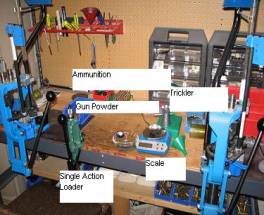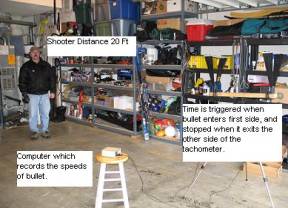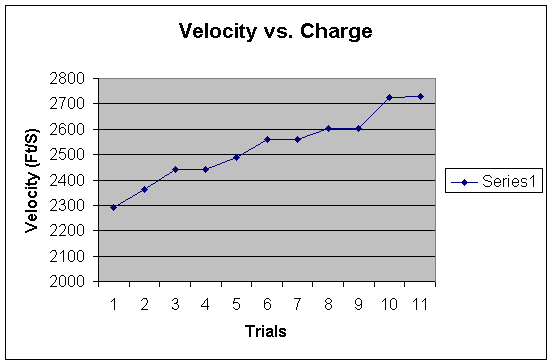

The AR15 is a semi automatic rifle which is precise and accurate. The small quantity of charge in the cartridge (gunpowder) will prevent the barrel from becoming too hot, thus altering our data. The cartridge is comprised of 4 parts: the primer, gun powder, casing, and bullet on the tip. The primer is a small explosive which is meant to create an inward explosion to ignite the gun powder inside. Once ignited, the gun powder will begin to burn, forming a gas which in turn builds pressure inside the casing. A bullet placed at the end of the casing prevents the pressure from escaping until enough of it has accumulated inside the cartridge. The bullet itself is the weakest part of the bullet and is designed to be forced off the casing and guided out the barrel. Once the pressure has built up to a certain point it escapes through the front forcing the bullet to exit the barrel and hurl towards its target. The set up for this bullet will contain Small Riffle Winchester Primers, Medium Speed Propellant Gun Powder, and Winchester Full Metal Jacket Bullets. The .223 casing will be made by Remington. Similar cartridges can also be found being shot by the United States Army. Our research on this subject seems to hint at the direct involvement of the charge the cartridge contains to the bullet’s velocity. It also tells us that the maximum load for a cartridge is 28 grains and the minimum is 23 grains. “Grains” is a unit used by cartridge manufacturers; the basic conversion for grains is 7000 grains per pound of gun powder. Over-loading a cartridge can cause severe damage to the rifle and to the shooter, while under-loading will cause the shooter to miss the target that the bullet was intended to hit. Therefore, when loading the cartridges, one must be keep the amount of gunpowder within the specified range.
The purpose of our investigation is to find
out the relationship between the amount of gun powder inside the cartridge of a
.223 AR15 and it’s affect on the velocity of the bullet leaving the barrel.
According to Speer Reloading Manual Riffle & Pistol, the bullet is directly affected be the amount of pressure in the casing; this is because of the amount of charge that the casing contains. They also state that the maximum and minimum reloading amount is 10% from the actual max because of uncertainties in mechanical reloading machines (Speer 51-58).
Winchester Ammunition suggests that the most accurate way of loading cartridges is by hand. They say this because the powder mechanism measures by volume and that it cannot be one hundred percent accurate, thus the 10% gap between the maximums and minimums. They also suggest that a “55 grain FMJ bullet, loaded with 26.2 grains will go 3170 feet per second” (Winchester 38).
Speer Reloading Manual Number 11 tells us that, “Powder measures are a fast, efficient way to measure a given amount of powder. Properly used, almost any measure will throw charges of fine kernel powders with variations of only a few tenths of a grain” (Speer11 74). This suggests that fine grain is more accurate to measure then the larger grain, thus our decision to use small Riffle Gun Powder.
According to Hodgdon Data Manual, The smallest amount that one should put into a .223 casing is 23 grains. There is also mention that the largest amount to be put into the cartridge safely is 28 grains (Hodgdon 144).
According to The Physics Factbook, “Gravity makes a projectile fall toward the earth while in flight. The projectile's size, shape, and the air density affect the speed by which it travels. Air resistance slows the speed of a bullet and reduces the distance by which it travels” (Elert 2). They also talk about how easy it is to manipulate the speed of a bullet, “With modern propulsion techniques, the projectile's initial velocity may be as high as 4000 feet (1200 meters) per second for some rifles and 5000 feet (1500 meters) per second for some large guns” (Elert 1).
We believe that the speed of the bullet will steadily increase as more charge is added into the casing. This is due to the pressure build up in the casing which in turn will have a greater force affecting the release of the bullet, making the velocity noticeably faster each time.
The first step that was taken was to analyze the information needed to correctly load bullets. After analyzing the needed equipment, a single action loader, trickler, and a scale were acquired. The next step was to gather the required powder and bullets to place in the cartridge. After acquiring all of these materials, we then proceeded to place the bullets together. It was necessary to make each bullet one by one, measuring out each specific amount of powder by hand with the trickler and scale. Using a funnel made for loading cartridges, we poured the powder into the cartridge which was then placed into the single action loader. The single action loader brings the cartridge up into a die which then compresses the bullet itself onto the cartridge. The next step after having made each bullet was to actually perform the experiment. The first action that we needed to perform was to find a wide, open field, large enough to shoot bullets in a safe manner. We located rock pit at Trask Mountain. In this rock pit, we placed the tachometer about twenty feet away from the shooter. The tachometer is comprised of a wooden 2’*4’ base with the laser readers mounted on each end. The two ends are then connected to a computer which computes the data each time a bullet is shot through the tachometer. After setting up the tachometer, a lab partner stood behind the shooter with a video camera to record any possible error that the shooter could have made. Also, a recorder wrote descriptions of what he observed each time a set of bullets was shot. The shooter stood twenty feet away from the tachometer, and shot one set at a time. Each set consisted of five trials (in case any error occurred). The velocity of each bullet shot through the tachometer was then recorded by the computer. The data was the transferred to a piece of paper by the recorder (lab partner). To have a clear graph of the velocity, eleven sets of data, with five trials for each were performed. The eleven trials consisted of the lowest recommended charge up to the highest recommended charge in increments of 0.4 grains. The next step was to condense each set of data into averages and to plot a graph to analyze the outcomes of the lab.


-AR-15 -Gunpowder -Powder Funnel
-Tachometer -Bullets -Video Camera
-AR-15 Magazine -Casing -Photo Camera
-Scale -Primers
-Trickler -Ear Muffs
-Single Action Loader -Tri-Pod
The independent variable is the amount of gun powder in the cartridge.
The dependent variable in our lab was the speed of the bullet which was affected by the charge.
|
Charge (Grains) |
Trail #1 (Ft/S) |
Trail #2 (Ft/S) |
Trail #3 (Ft/S) |
Trail #4 (Ft/S) |
Trail #5 (Ft/S) |
Average (Ft/S) |
|
22.2 |
2285 |
2342 |
2217 |
2340 |
2280 |
2292.8 |
|
22.6 |
2408 |
2412 |
2375 |
2303 |
/ |
2364.5 |
|
23 |
2488 |
2356 |
2426 |
2492 |
/ |
2440.5 |
|
23.4 |
2533 |
2420 |
2408 |
2499 |
2345 |
2441 |
|
23.8 |
2548 |
2443 |
2462 |
2489 |
2495 |
2487.4 |
|
24.2 |
2506 |
2614 |
2583 |
2532 |
/ |
2558.75 |
|
24.6 |
2536 |
2510 |
2633 |
/ |
/ |
2559.6 |
|
25 |
2690 |
2567 |
2549 |
2568 |
2649 |
2604.6 |
|
25.4 |
2654 |
2530 |
2554 |
2632 |
2681 |
2604.2 |
|
25.8 |
2630 |
2755 |
2804 |
2728 |
2728 |
2727 |
|
26.2 |
2630 |
2755 |
2804 |
2728 |
/ |
2729.25 |

According to our results, the hypothesis proves to be correct. As we increased the charge (amount of gunpowder) in each bullet there was a trend in our graph showing that the velocity was also noticeably increasing. The results are consistent due to the fact that, as expected, adding more gunpowder to the cartridges will create a more powerful explosion inside the barrel; thus, the bullet will travel with a greater velocity. The graph shows that the velocity does in fact increase steadily as the amount of charge increases by 0.4 grains each trial. The difference in the amount of grains between each trial is quite small (0.4 grains). However, this does seem to make a significant difference in the corresponding values for velocity. This means that when loading cartridges with gunpowder, one must be quite precise in doing so. This is because the safe range of amount of gunpowder in a cartridge is 23 to 28 grains. Therefore, it is quite easy for someone to load a bullet with too much or too little gunpowder if he/she does not use proper loading equipment resulting in injury or damage to the gun. The borderline dividing safety from danger can therefore be easily crossed. If someone wants to acquire a certain velocity to reach a known distance, they must precisely measure the amount of powder in the casing and decide how much is needed to do what they want. This can be applied to sharp shooters or shooting contests where the people in the contest have to hit targets at certain distances. For them this is a science which needs to be exact, with almost no error.
During the trials, some of the velocities were not recorded by the computer. Our first thought was that the problem was due to the shots being fired within too small of intervals for the computer to read the velocities and record them. We later deduced that the reason for the problem was that the bullet passed about an inch too high above the sensors in the tachometer which would then prohibit the computer to read the velocity. We then assessed that the tachometer is very delicate and needs bullets to pass close above the radars in order to trigger the timer. Another source for error may have occurred during the actual loading of the cartridge; we deduced this because it seemed as though some of the velocities were quite different from each other, even in the same set. After taking the average of each set of data, the velocity graph does steadily increase; however, the data may have been more accurate if the cartridges had been loaded more precisely. The reason for error during loading is due to the scale or trickler which may have had some grains adhere to it while pouring them in the cartridges. The scale itself is also very sensitive, so one grain left on the scale from a previous charge may have altered the weight of the next. The funnel which we used to pour the powder into the casing may have also prevented 100% of the weighed powder from entering the cartridge. If this were the case, then it is possible that these are the reasons for the difference in velocities within the same set. Also, if the bullets were not shot from the same distance away from the tachometer, then some more error could have occurred. If the shooter stood too close to the tachometer, the flash projected out of the muzzle would have affected the sensors from recording the velocity properly.
The extreme temperature difference between the gun and the environment may have also affected the speed. The actual temperature outside was below freezing level, while the heat of the barrel seemed to be above 90 degrees; this means that the temperature difference could have had an effect on the experiment. Furthermore, due to the fact that the barrel became increasingly hot as more shots were fired, the metal expanded. This expansion made it easier for the bullets to pass through the barrel with less friction with the walls of the gun. The experiment was performed at a very high altitude on a mountain. Therefore, due to the decreased atmospheric pressure, the velocity of the bullet may have been affected. Due to the fact that at a higher altitude resulted in less pressure and air resistance, the bullet may have been allowed to travel faster than it actually would at sea level.
The many factors that could have contributed to errors could be reduced in various ways. The first error, being due to the tachometer, could be reduced with a better, more recent piece of equipment. Also, to keep the bullet from passing too high above the sensors in the tachometer, the weapon could be stabilized on top of a tri-pod while being shot. Also, if the weapon was placed at a fixed point, at a certain distance and height, error could be reduced by preventing the weapon from moving constantly. The error that could have occurred during loading could be minimized by using a more sophisticated scale, which shows readings with more significant figures. While loading the cartridges with gun powder, we could be extremely cautious to make sure that each individual grain did not adhere to the funnel. This could be done by using a lightly powered air tool to assure that all of the powder is pushed into the casing. We could also perform the lab in a different location, where environmental conditions such as temperature and atmospheric pressure are optimal for shooting. Using a flash suppressor could have prohibited the extra release of gases which were not burned efficiently, preventing the flash from interfering with the sensors on the tachometer. Also, using a higher grade of gun powder, which has a higher burn rate, would assure that most of the charge is released through pressure rather than fire. Again, there are many factors that could have contributed to error; thus there is a great chance that if even some of these errors can me minimized to a certain extent our results could have been slightly more accurate.
Due to the fact that the grain is so small, some of it could have been lost on the way to loading the cartridges. Thus, we decided that the uncertainty is +/- 1 grain.
Elert, Glenn. “Speed of a Bullet.” Physics Handbook. 20, Nov. 2004.
http://www.hypertextbook.com.com/facts/1999/mariaperoyo.html
Hodgdon, R.E. Hodgdon Data Manual No. 26. Slewnee Mission, KA. Hodgdon Powder Inc. 1992.
Speer, Vernon. Reloading Manual No. 11. Lewis, ID. Omark Industries Inc. 1987.
Speer, Vernon. Speer Reloading Manual No. 13. Lewiston, ID. Blout Inc. 1998.
Winchester Ammunition. Reloader’s Manual 15th Edition. East Alton, IL. Ollin Co. 1997.
Best search engine to use when researching guns/anything.
This website provides good information for people who are interested in buying guns, and finding out specifications on certain guns.
This website provides information on their firearm products as well as their reloading equipment and reloading statistics.
This website provides information on gun laws and the constitution. This website also promotes gun safety, and the second amendment.
This is an informational website that contains a glossary of general terms used to describe firearms and related items such as ammunition. The website is a dictionary that defines many different terms used by enthusiasts.
This website offers information on ballistics from a scientific point of view. It describes the inner workings of everything from the explosion inside the barrel that propels the bullet to the energy involved.